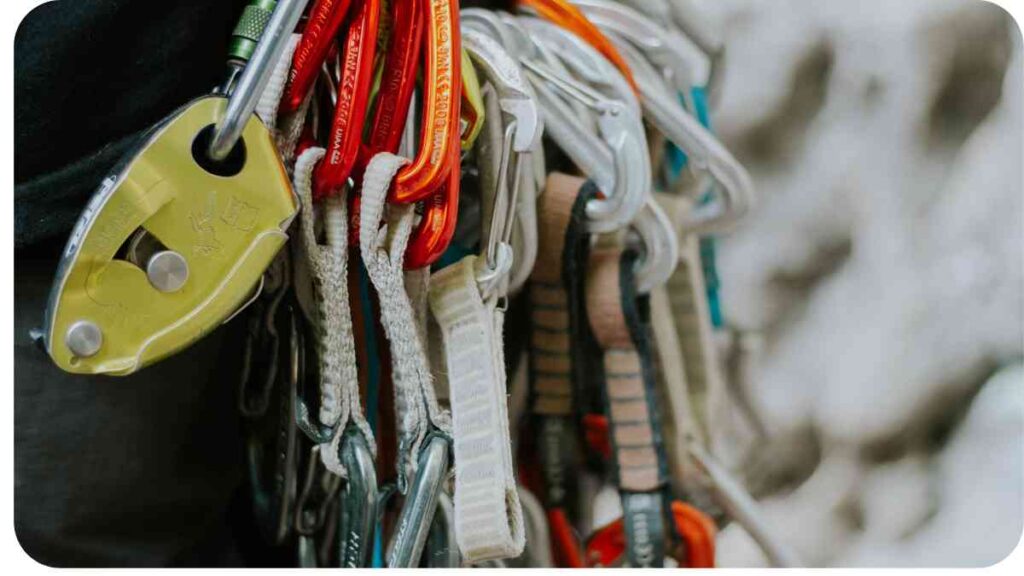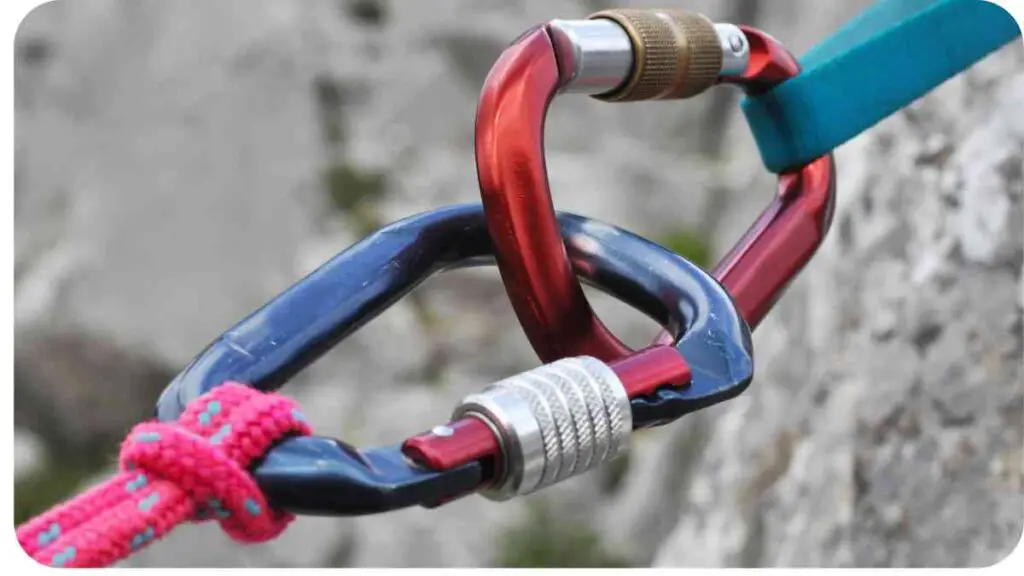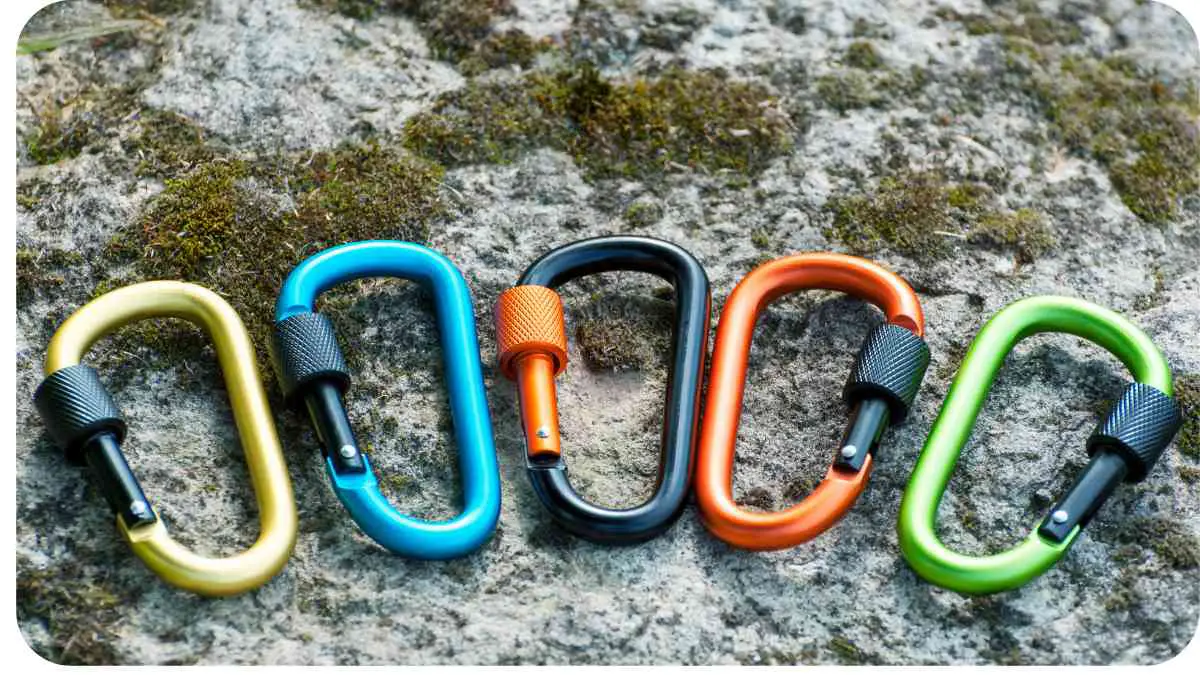Carabiners are essential tools used in various activities like rock climbing, mountaineering, and rescue operations. They are relied upon to secure ropes and anchor points, acting as critical links that ensure safety.
However, there can be instances where carabiners become jammed, compromising their smooth operation and potentially putting lives at risk. In this article, we will explore the causes of carabiner jamming, provide tips to prevent it from happening, and offer troubleshooting techniques to address the issue effectively.
Takeaways
| Carabiners are essential tools used in various activities such as rock climbing, mountaineering, and rescue operations. |
| Proper gate alignment and regular cleaning are key to preventing carabiner jamming. |
| Choosing the right carabiner for the job and using gate flap technology can enhance smooth operation. |
| Troubleshooting techniques include clearing rope snags and gently unjamming gates. |
| Remember to prioritize safety, follow manufacturer guidelines, and maintain carabiners in good working condition. |
Understanding Carabiners
Before delving into the causes and solutions for carabiner jamming, it’s crucial to understand the different types of carabiners and their components. Carabiners typically consist of a gate, spine, and nose. The gate is the moving part that opens and closes, allowing attachment or detachment to various anchors. The spine provides strength and stability, while the nose secures the rope during use.
When you’re on the edge, safety is paramount. Ensure a smooth descent with proper belay techniques. Learn more about safe belay practices today.
Common Causes of Carabiner Jamming

Gate Alignment Issues
One common cause of carabiner jamming is gate misalignment. When a carabiner is overloaded or subjected to excessive force, the gate can become skewed or bent, making it difficult to open or close smoothly. Additionally, improper gate alignment can occur due to mishandling or accidental impact against a hard surface.
To better understand the significance of gate alignment, refer to the following table that highlights various carabiner brands and their gate alignment mechanisms:
Rope Snagging
Another prevalent cause for carabiner jamming is rope snagging. When ropes get caught in the carabiner’s gate or nose, it can hinder its smooth operation. This can happen due to improper handling or when the rope is not properly threaded through the carabiner. Furthermore, worn-out ropes with frayed edges can be more prone to snagging.
To better comprehend the impact of rope snagging, consider the following table showcasing different carabiner models and their susceptibility to rope snagging:
Altitude sickness can be a real challenge in high climbs. Understand the causes, symptoms, and effective altitude sickness remedies to conquer the heights safely.
Dirt and Debris Accumulation
Accumulation of dirt, sand, or debris within a carabiner can significantly impair its functionality. When foreign particles enter the gate mechanism or clog the spine and nose, it can cause friction and hinder smooth gate operation. It is crucial to keep carabiners clean and free from any obstructions to ensure reliable performance.
Let’s take a look at the table below to understand the cleaning requirements and recommendations for various carabiner brands:
Tips for Preventing Carabiner Jamming

To avoid carabiner jamming, it is vital to follow preventive measures and practice regular maintenance. Here are some tips to keep your carabiners functioning smoothly:
Regular Cleaning and Maintenance
Maintaining clean carabiners is essential to prevent jamming. Regularly inspect your carabiners, removing any accumulated dirt, sand, or debris. Clean them using a mild soap and water solution or as recommended by the manufacturer. Additionally, lubricate the moving parts with a dry lubricant to ensure smooth operation.
For a quick reference on cleaning and maintenance requirements, consult the table below:
Don’t let fraying ropes hold you back. Discover the reasons behind rope wear and the best rope fraying remedies for a secure ascent.
Proper Gate Alignment
To avoid gate alignment issues, ensure that you handle your carabiners carefully. Avoid subjecting them to excessive force or impact against hard surfaces. When attaching the carabiner to an anchor point or rope, check the
gate alignment to ensure it is properly aligned and functioning smoothly. Some carabiners have locking mechanisms like screw locks, twist locks, or auto-locking systems, which further enhance gate stability and prevent jamming.
Refer to the table below for a comparison of different carabiner brands and their gate alignment mechanisms:
Using the Right Carabiner for the Job
It is crucial to select the appropriate carabiner for different activities. Consider the size, shape, and strength requirements of the carabiner based on the task at hand. Different carabiners are designed for specific purposes, such as sport climbing, trad climbing, or rescue operations. Using the right carabiner ensures optimal functioning and reduces the risk of jamming.
Let’s take a look at the following table, which showcases various carabiner models and their recommended applications:
Using Gate Flap Technology
Gate flap technology is an innovation that addresses the issue of carabiner jamming. Some carabiners have an additional flap or hinged gate mechanism that covers the opening, offering added protection against snagging and preventing accidental openings. This technology enhances the overall smooth operation of carabiners, reducing the chances of jamming.
To gain a better understanding, refer to the following table showcasing carabiner brands that incorporate gate flap technology:
Troubleshooting Carabiner Jamming
Even with the best preventive measures, carabiner jamming may still occur. It is essential to know how to troubleshoot the issue to ensure a smooth operation. Here are some tips to troubleshoot carabiner jamming:
Struggling with grip during bouldering? Learn how to enhance your hold and prevent slip-ups while climbing. Explore effective grip improvement techniques now.
Clearing Rope Snags
If the carabiner gets jammed due to rope snagging, carefully remove the rope from the gate or nose. Gently untangle the rope and ensure that there are no frayed edges or knots that could cause further snags. Properly thread the rope through the carabiner, paying attention to the orientation and alignment to avoid future snags.
Unjamming Gates
In case of gate misalignment or jamming, gently manipulate the gate to realign it. Avoid using excessive force as it can further damage the carabiner. If necessary, use a small tool like a carabiner tool or a flathead screwdriver to assist in unjamming the gate. Take care not to scratch or deform the carabiner during the process.
Achieve the perfect grip balance with chalk. Find out how to overcome chalk consistency issues for improved climbing performance. Explore our guide on chalk consistency today.
Conclusion
Carabiners are vital tools in various activities requiring rope work and anchoring systems. To ensure smooth and safe operations, it is crucial to address carabiner jamming effectively. By understanding the common causes of jamming, practicing preventive measures, and knowing how to troubleshoot, you can minimize the risk of carabiner malfunction.
Remember to choose the right carabiner for each task, regularly inspect and clean them, and ensure proper gate alignment. With these tips in mind, you can enjoy your outdoor activities with confidence, knowing that your carabiners will function smoothly and reliably.
Further Reading
Here are some additional resources that you can explore to deepen your knowledge about carabiners, their usage, and related topics:
- Carabiner in Tree Care, Climbing, and Rigging: This informative article highlights the importance of using the right carabiner for tree care, climbing, and rigging activities. It covers different types of carabiners, their features, and usage considerations.
- 9 Zipline Mistakes You Don’t Know You’re Making: This blog post focuses on zipline-related mistakes that are commonly overlooked. While not directly about carabiners, it provides valuable insights into safety considerations and best practices when using carabiners in zipline setups.
- Introduction to Climbing Carabiners: This comprehensive guide offers an introduction to climbing carabiners. It covers different types, features, and uses of carabiners in the context of climbing. It also provides tips on how to choose the right carabiner for specific climbing scenarios.
FAQs
How can I identify if my carabiner is jammed?
A jammed carabiner may exhibit difficulty in opening or closing the gate smoothly. If you find that the gate is misaligned or doesn’t move freely, it is an indication of a potential jam. Inspect the gate for any visible obstructions or signs of damage.
Can I use any carabiner for rock climbing?
No, not all carabiners are suitable for rock climbing. Different types of carabiners are designed for specific applications. It is important to use carabiners that are specifically made for climbing and meet the necessary safety standards. Refer to the manufacturer’s guidelines and choose carabiners that are certified for climbing use.
How often should I clean my carabiners?
Regular cleaning is essential to maintain the performance of your carabiners. It is recommended to clean them after each use or at least once a month, depending on your frequency of use. Cleaning removes dirt, debris, and built-up particles that can impair the smooth operation of the carabiner.
Can I repair a jammed carabiner myself?
In most cases, minor issues with carabiners can be resolved by gently manipulating the gate or removing any obstructions. However, if you notice significant damage or structural issues, it is recommended to retire the carabiner and replace it with a new one. It is crucial to prioritize safety and ensure that your gear is in good working condition.
Are there any specific maintenance tips for carabiners used in water activities?
Carabiners used in water activities, such as diving or water rescue, are exposed to additional elements that can lead to corrosion. It is important to rinse them thoroughly with fresh water after each use in saltwater or chlorinated environments. Additionally, consider using corrosion-resistant carabiners specifically designed for water activities to ensure longevity and optimal performance.
Please note that these answers provide general guidance. It is always important to consult specific manufacturer recommendations and safety guidelines related to your carabiners and activities.

Welcome to my blog! I’m Hellen James, and I’m incredibly passionate about rock climbing, bouldering, ice climbing, and mountaineering. Join me as I embark on thrilling adventures, conquer vertical challenges, and share my experiences and insights with fellow outdoor enthusiasts.


